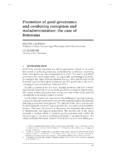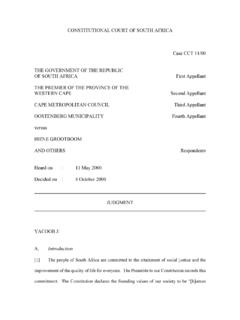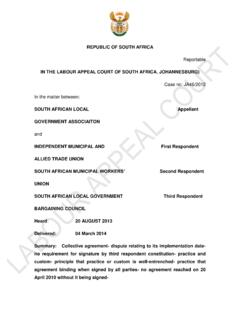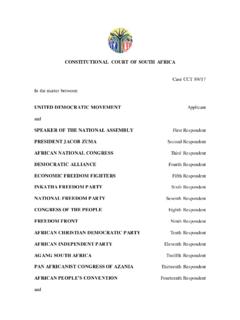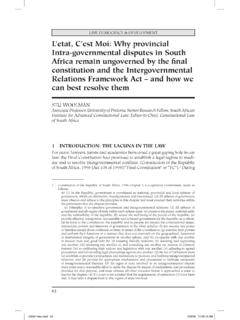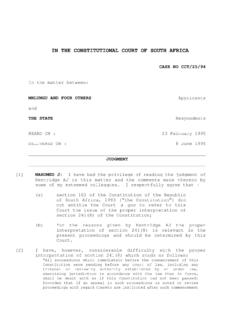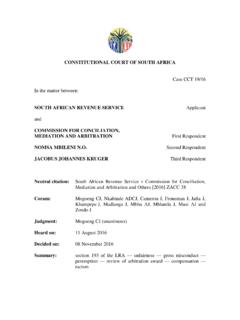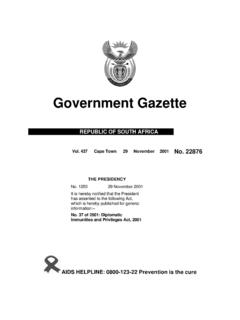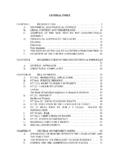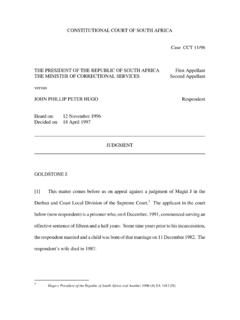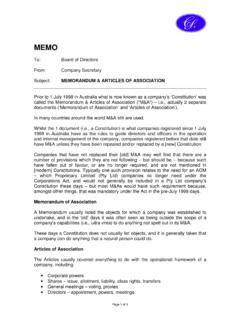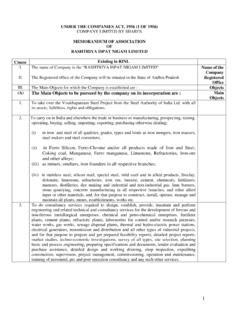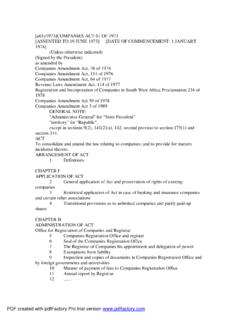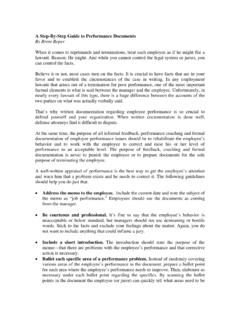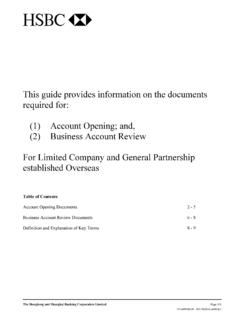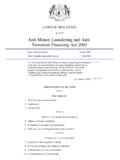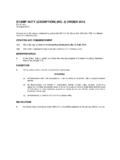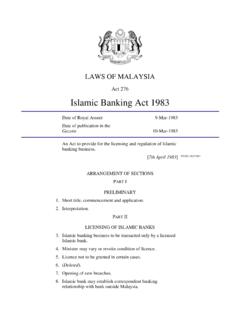Transcription of IN THE HIGH COURT OF SOUTH AFRICA - SAFLII Home
1 IN THE high COURT OF SOUTH AFRICA (WESTERN CAPE DIVISION, CAPE TOWN) Reportable CASE NO: 4308/2015 In the matter between: NICOLAAS JOHANNES DU PLOOY First Applicant CATHERINA MAGDALENA DU PLOOY Second Applicant NICOLAAS JOHANNES DU PLOOY Third Applicant HAROLD MEYER LIVERSAGE Fourth Applicant SANDRA VAN DER WESTHUIZEN Fifth Applicant And DE HOLLANDSCHE MOLEN SHARE BLOCK LTD First Respondent THE SHAREHOLDERS OF ORDINARY A CLASS SHARES IN DE HOLLANDSCHE MOLEN SHARE BLOCK LTD Second Respondent _____ JUDGMENT: 11 November 2015 _____ DAVIS J Introduction [1] This case has been fuelled by a major feud between third applicant personally as well as in his capacity as a representative of the NJ Du Plooy Trust ( the trust ), which is the majority shareholder of first respondent on the one hand and the board of directors of the first respondent ( the board ) on the other.
2 This feud has not only created significant problems for the running of first respondent, a 2 share block company, but it has now raised a veritable hast of intricate legal questions which, in some cases, go to the heart of company law. [2] In essence, the first and second applicants seek an order that the trust, as a registered owner of a series of shares of first respondent, and alternatively, in the event of it being found that the trust has not been entered into the security register of the first respondent as the owner of these shares, that the first respondent be ordered to enter the name of the trust in the first respondent s security register as the owner of all the shares referred to as class B - F shares. In the alternative, applicants seek an order that the trust is entitled to exercise voting rights in respect of the shares at any meeting of the shareholders of the first respondent.
3 The broad factual background [3] It appears to be common cause that first respondent was incorporated and registered as a company on 18 November 1991 with an authorised share capital of 35 600 shares comprising of the following classes of shares of 1c each: 6 980 class A shares, 540 class B shares, 10 000 class C shares, 6 000 class D shares, 2 080 class E shares, and 10 000 class F shares 3 [4] At all relevant times since 2004, the first respondent and the board recognised the trust as a majority shareholder of first respondent and the registered owner of all the class B F shares. In September 2014, the board adopted the position that the trust was not the shareholder of first respondent because its name had not appeared on the document that the board contended is the share register of first respondent.
4 [5] Although the board adopted this decision in September 2014, the dispute had begun to brew somewhat earlier. During 2011 a dispute arose between the trust and the first respondent when the board took the position that the first respondent was obliged in terms of the Companies Act of 2008 to amend its memorandum and articles of association . The first respondent appointed Werksmans Attorneys to advise it on the implications of this amendment. On 10 July 2012 an attorney from Werksmans attended a board meeting to advise first respondent on these matters. [6] First respondent alleged that, prior to this meeting, it had already engaged in discussions with the applicant with regard to various issues, inter alia, greater voting rights and greater representation of the board for class A shareholders.
5 [7] In 2012 negotiations took place between the board and the trust concerning the proposed draft of the new memorandum of incorporation in terms of the 2008 Companies Act. 4 [8] First respondent alleged that since early 2013 it attempted to align its founding documents , that is the existing memorandum and articles of association with the provisions of the 2008 Companies Act. These negotiations between the trust and first respondent were protracted but ultimately proved to be unsuccessful. The board then began to raise a number of complaints with regard to third applicant s conduct as a director of first respondent. On 14 August 2014, in order to protect its interest, the trust requested first respondent, in terms of article of the Articles read together with s 61 (3) of the 2008 Companies Act, to convene a general shareholders meeting in order to consider and vote upon a resolution for the removal of the then directors and the appointment of new directors in their stead.
6 In the header to this notice the trust informed first respondent that it requested a shareholders meeting in its capacity as the holder of 82% of the issued shared capital of the first respondent. [9] First respondent complied with this request and gave notice of a special general meeting of shareholders to be scheduled for 20 September 2014. It added to this notice a series of items that first respondent intended to put to the vote. The first order of business was to resolve the impasses between the board and the majority shareholder in the company, the Du Toit Plooy Trust relating to the company s memorandum of incorporation . The first respondent attached a voluminous bundle of annexures to this notice, inter alia, a memorandum to the shareholders that contained the following paragraph: Company s share register 5 It has furthermore come to the attention of the board that due to the amendments to the share blocks and the registered Plan, the Company s share register is incorrect for the reasons more fully set forth in Werkmans e-mail dated 4 April 2014.
7 (my emphasis) In paragraph of this memorandum , the shareholders were informed of the following matters that needed to be resolved: 9. To be resolved by shareholders Whether or not the Outstanding Matters and any other matter to be raised by the Trust, as majority shareholder (approximately 83% shareholding) and contributor of approximately to the levies raised by the Company from time to time, should simply be accepted, to ensure that the MOI is finalised and registered as soon as possible, OR should the Company seek the appropriate relief against Du Plooy and/or the Trust to ensure the finalisation of the revised (my emphasis) On 1 September 2014 the trust s attorney directed the following inquiry to the first respondent in regard to this paragraph.
8 In view of the content of para of the aforesaid memorandum , we require confirmation from the Board of Directors of the Company, that the Trust holds approximately 83% of the shareholding in the company and that they will be entitled to exercise their vote at the meeting to be held on 20 September 2014. If this is not the case, kindly inform us what according to the Board of Directors, is the shareholding of the Trust and/or (on) what basis the Trust would not be able to vote on the basis of such shareholding. The first respondent s attorney replied, inter alia, as follows: 6 Lastly, your client will be permitted to vote in accordance with the provisions of the Companies Act, 71 of 2008, and your client s shareholding will be determined in accordance therewith at the envisaged meeting.
9 [10] At the meeting of 20 September 2014 discussions took place which culminated in an agreement that the meeting be postponed and that the parties attempt to settle the issues pertaining to the amendment of the company s founding documents and the use agreement. It was during these discussions that first respondent s attorney stated that, according to his client, the trust was not reflected in the share register as a shareholder and, as a consequence, the trust would not be permitted to be present and vote at any shareholders meeting. [11] A further meeting was held on 25 September 2014 to discuss the proposed terms of the memorandum of Incorporation (MOI) and related issues. The trust attorney made it clear that the trust was not prepared to commence any discussions with first respondent on the basis that, in the event that the discussions were unsuccessful, the board would persist in its attitude that the trust was not entitled to be present and to vote at any reconvened meeting of shareholders.
10 [12] Pursuant thereto, first respondent s attorney informed the trust s attorney that, regardless of the outcome of the settlement negotiations, first respondent would not persist in the positions adopted, namely that the trust may not be present and vote at any reconvened shareholders meeting. However, it appears that the board did reconvene the postponed meeting which had been scheduled for 11 October 2014. 7 At this meeting the trust was allowed to vote, although upon the instructions of the board, the respective votes of the A class shareholders and the trust were counted and recorded separately. The outcome was that the majority of the A class shareholders voted for the adoption of the six proposals put up by the board and the trust, as well as the fourth and fifth applicants, and a substantial number of A class shareholders voted for the removal of the directors.
